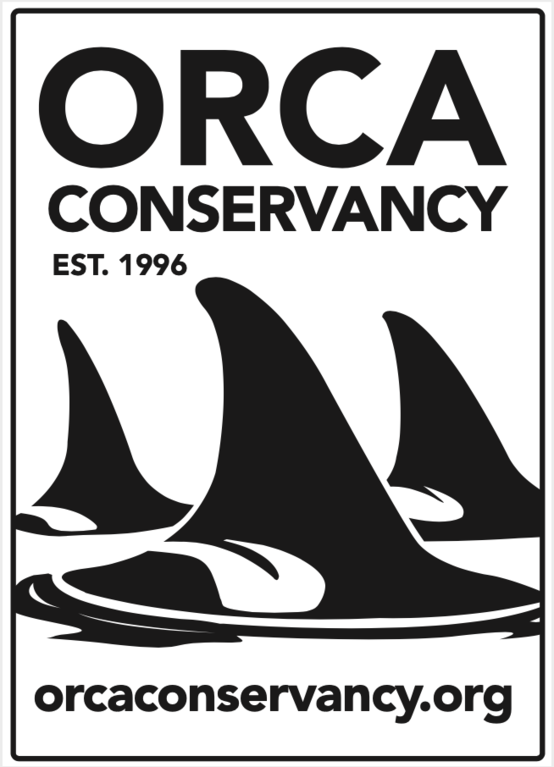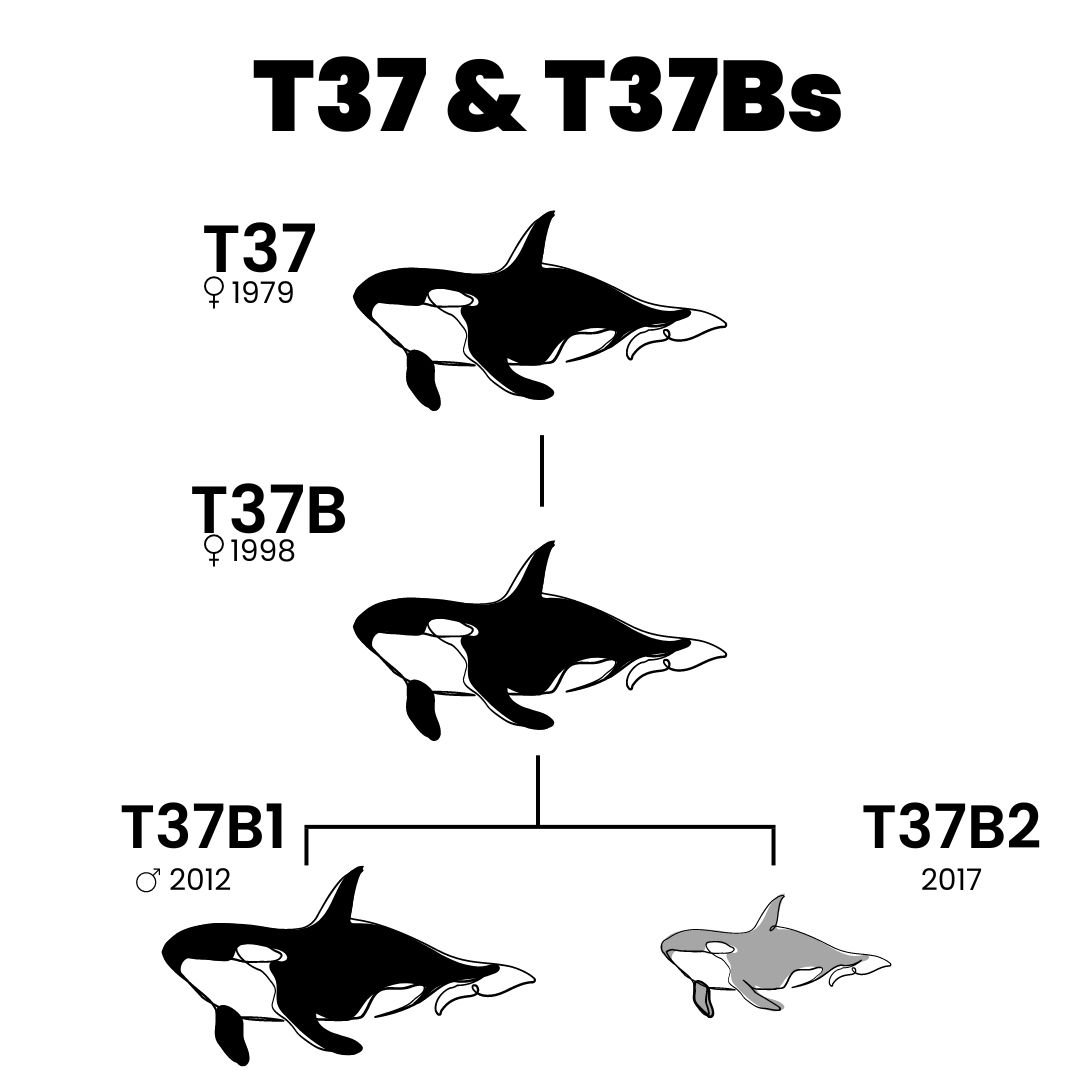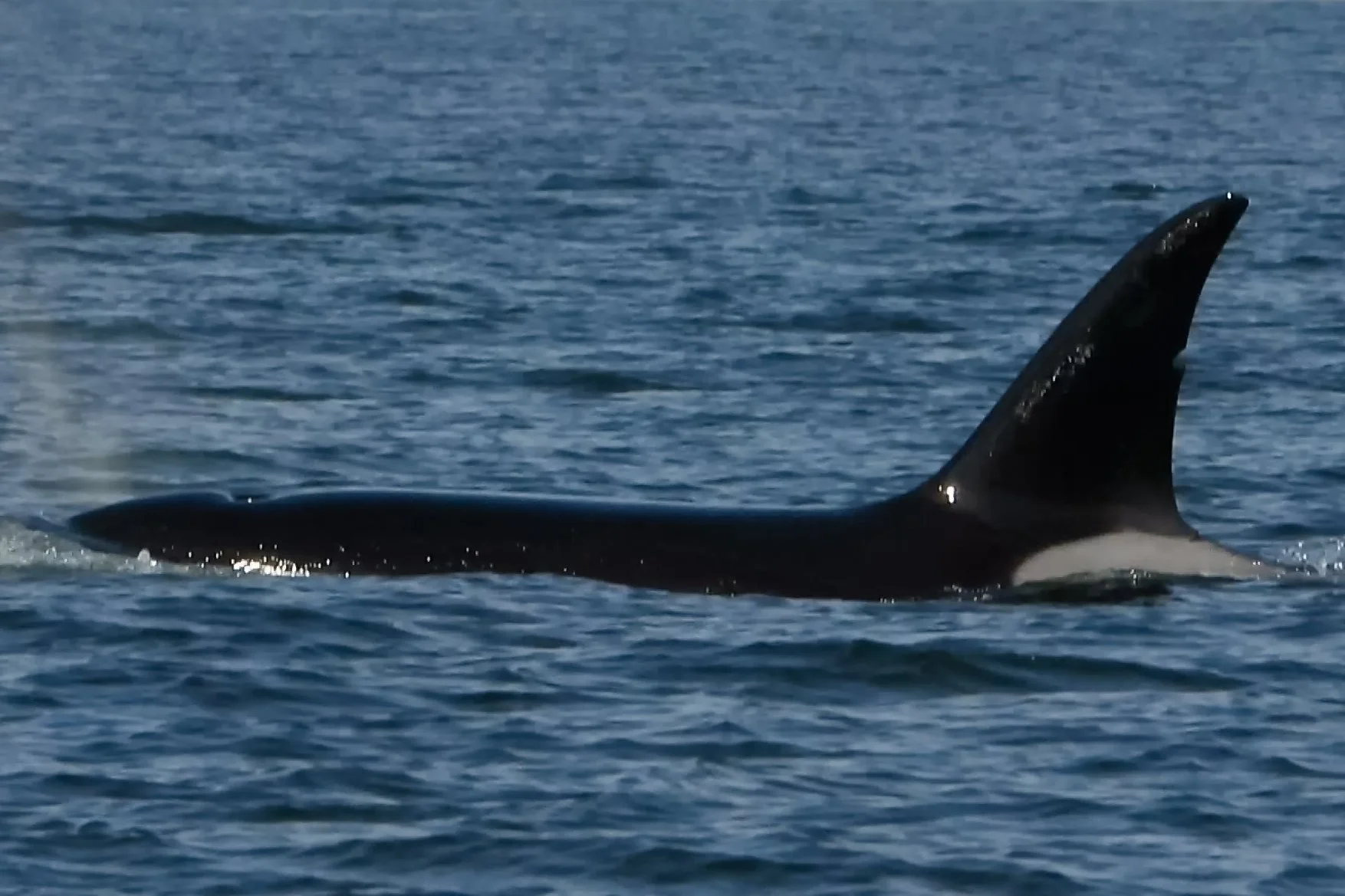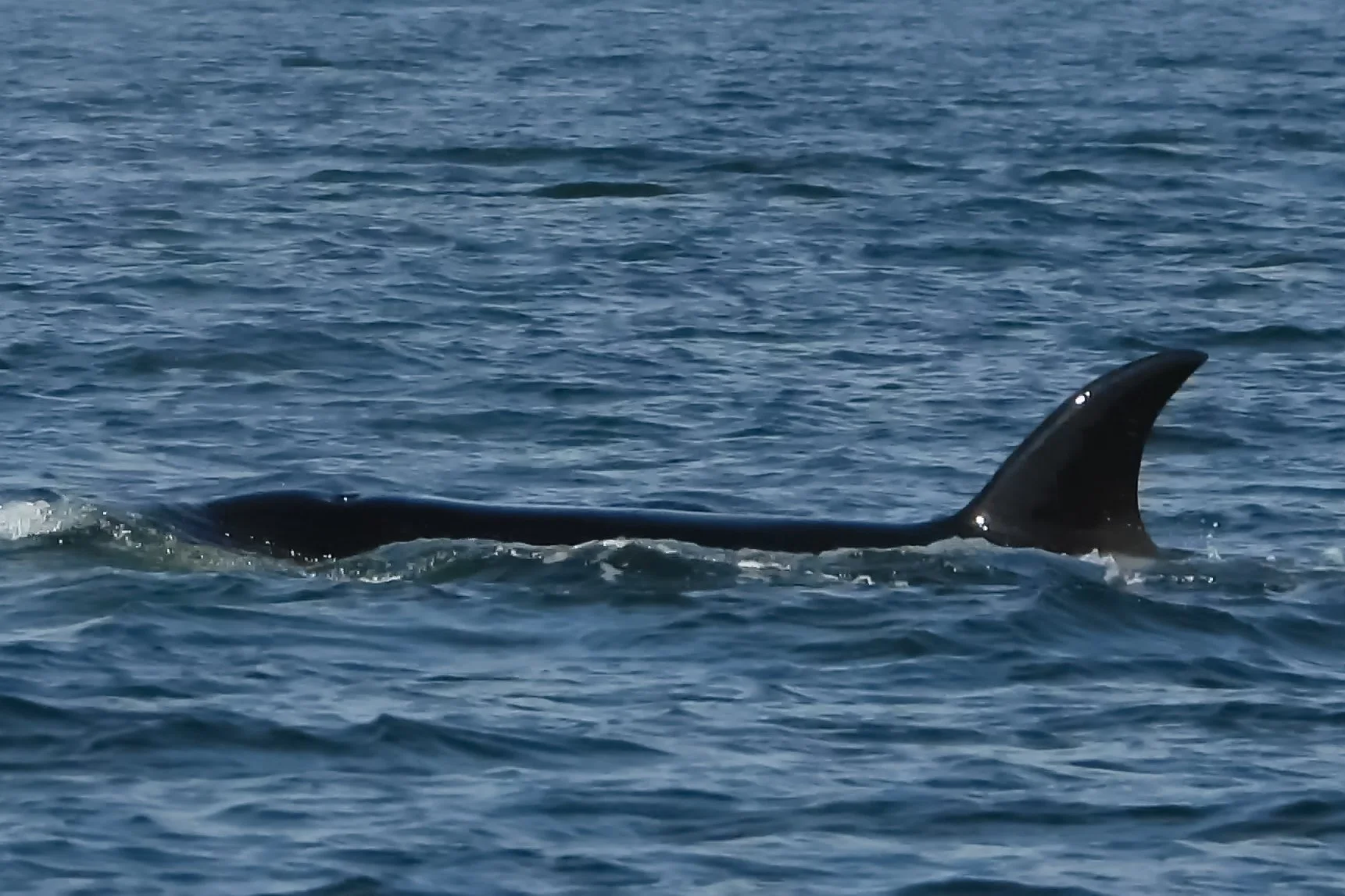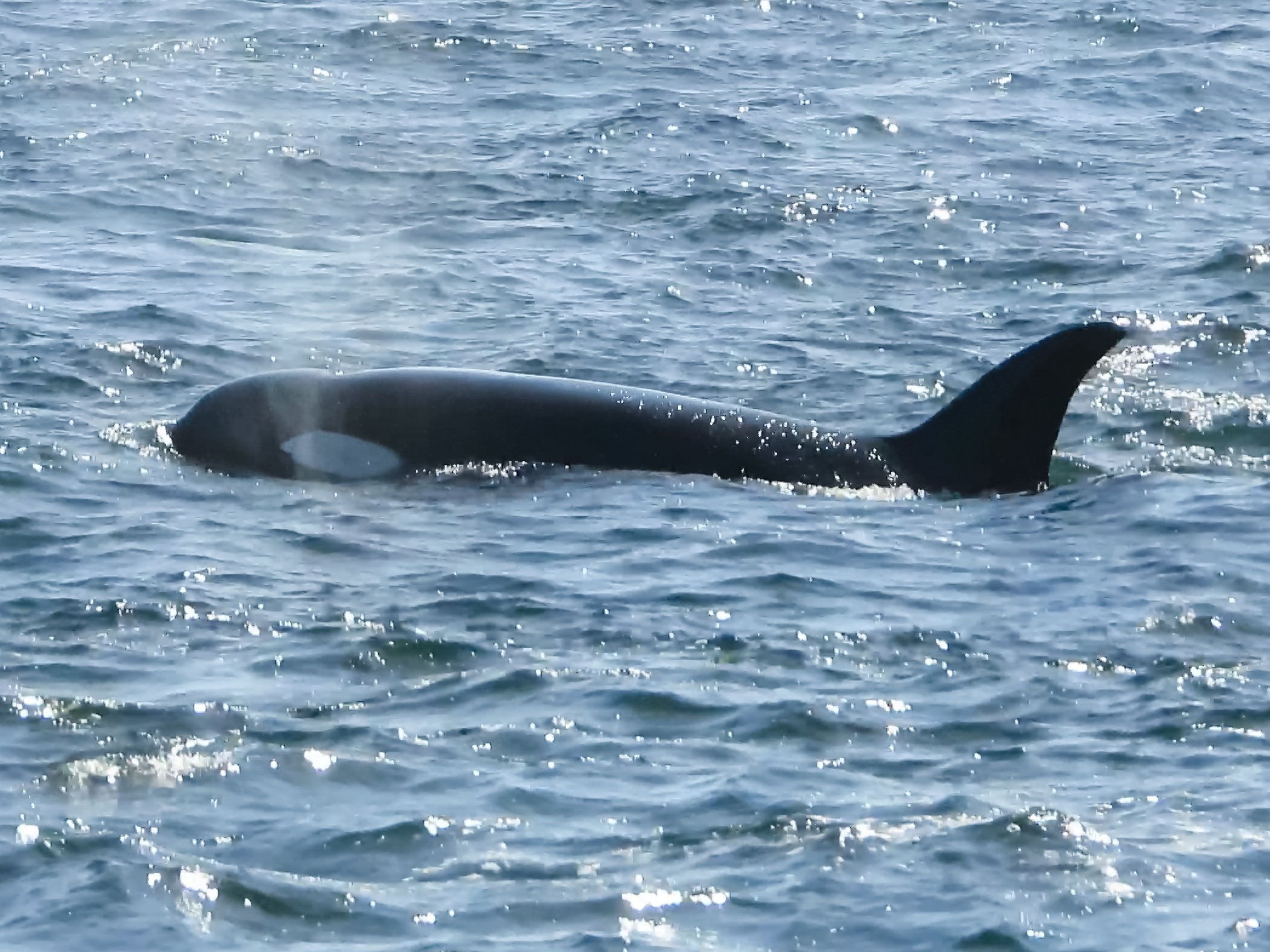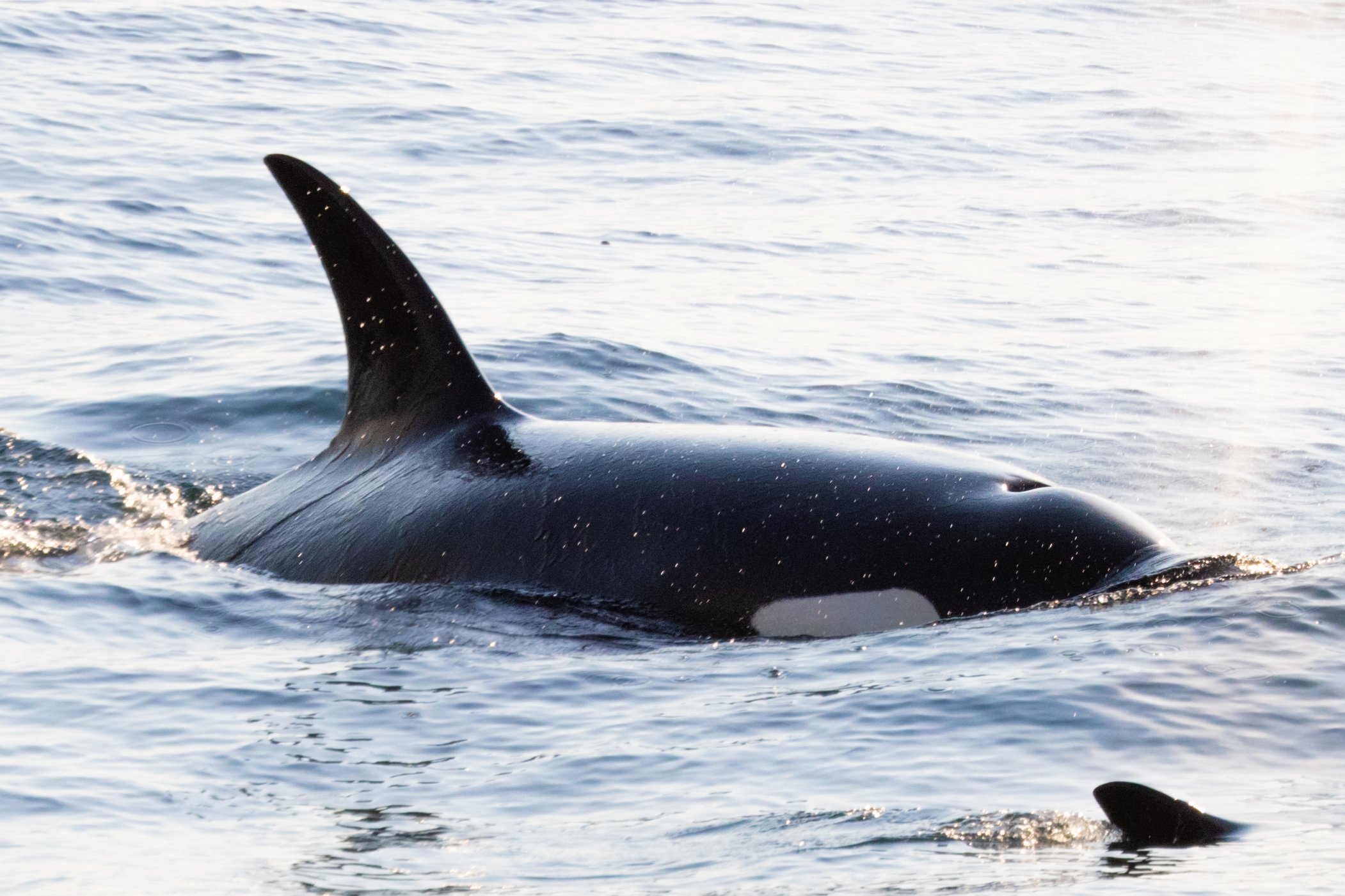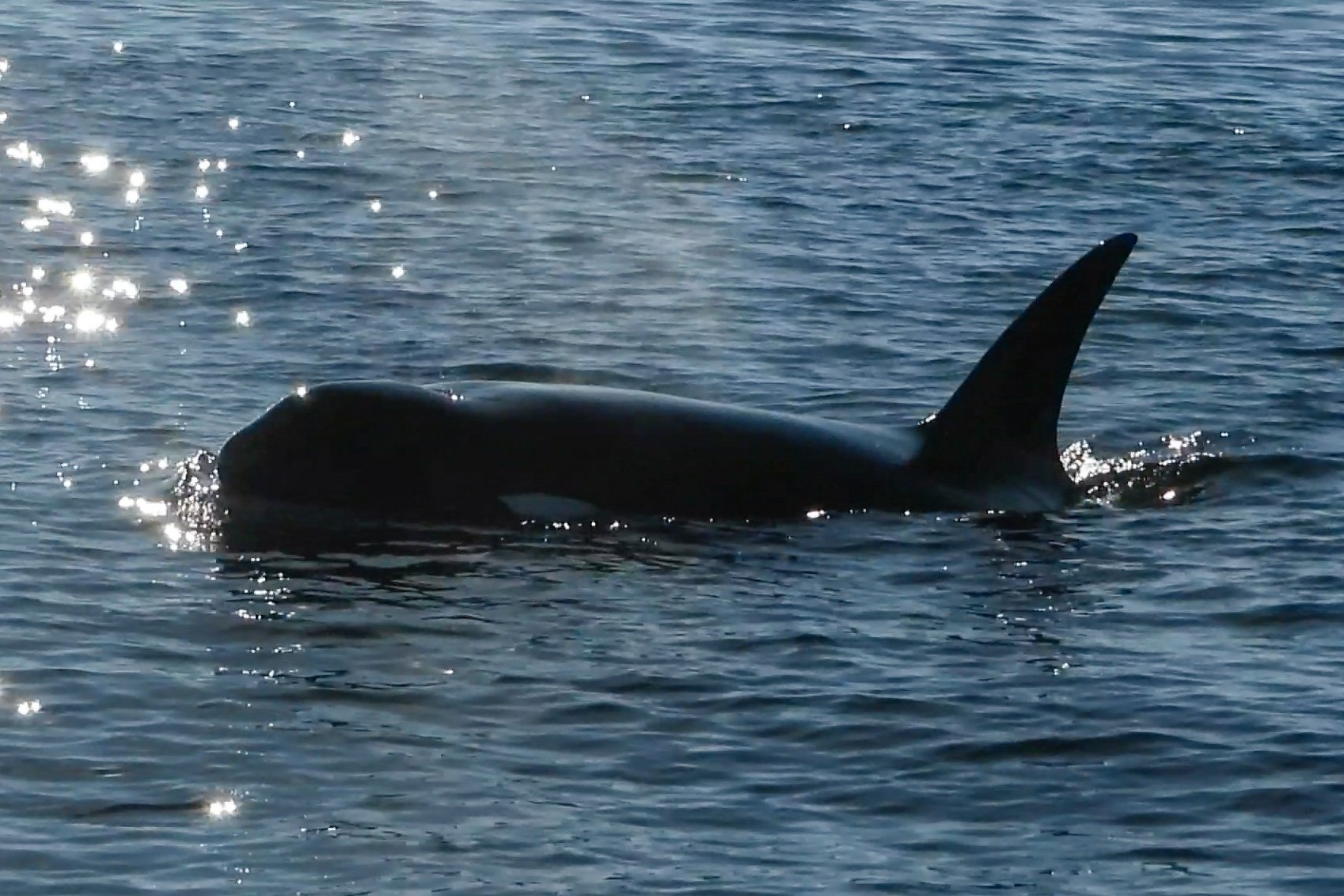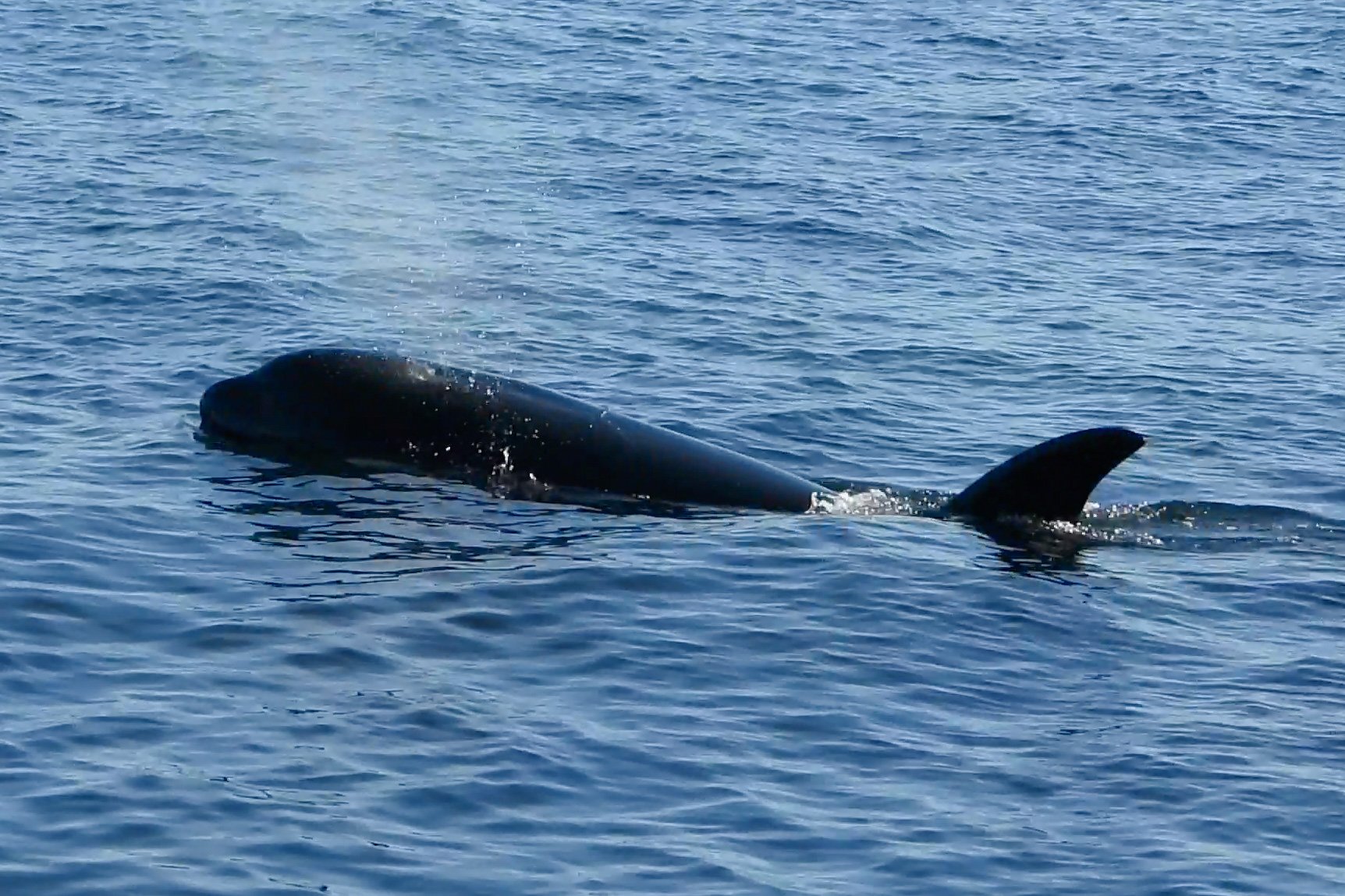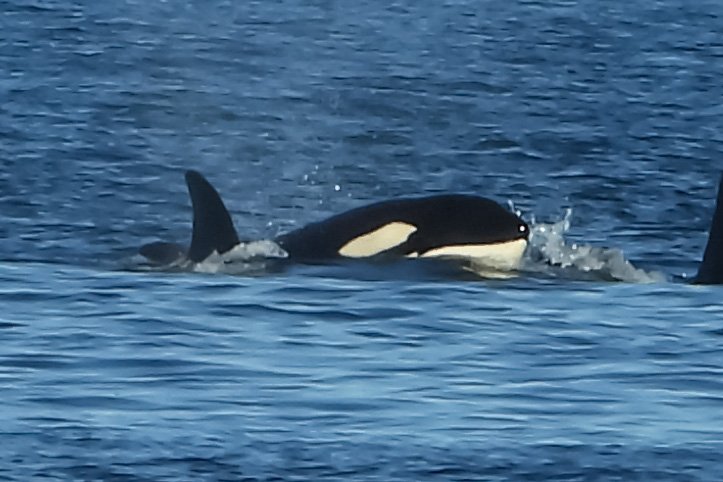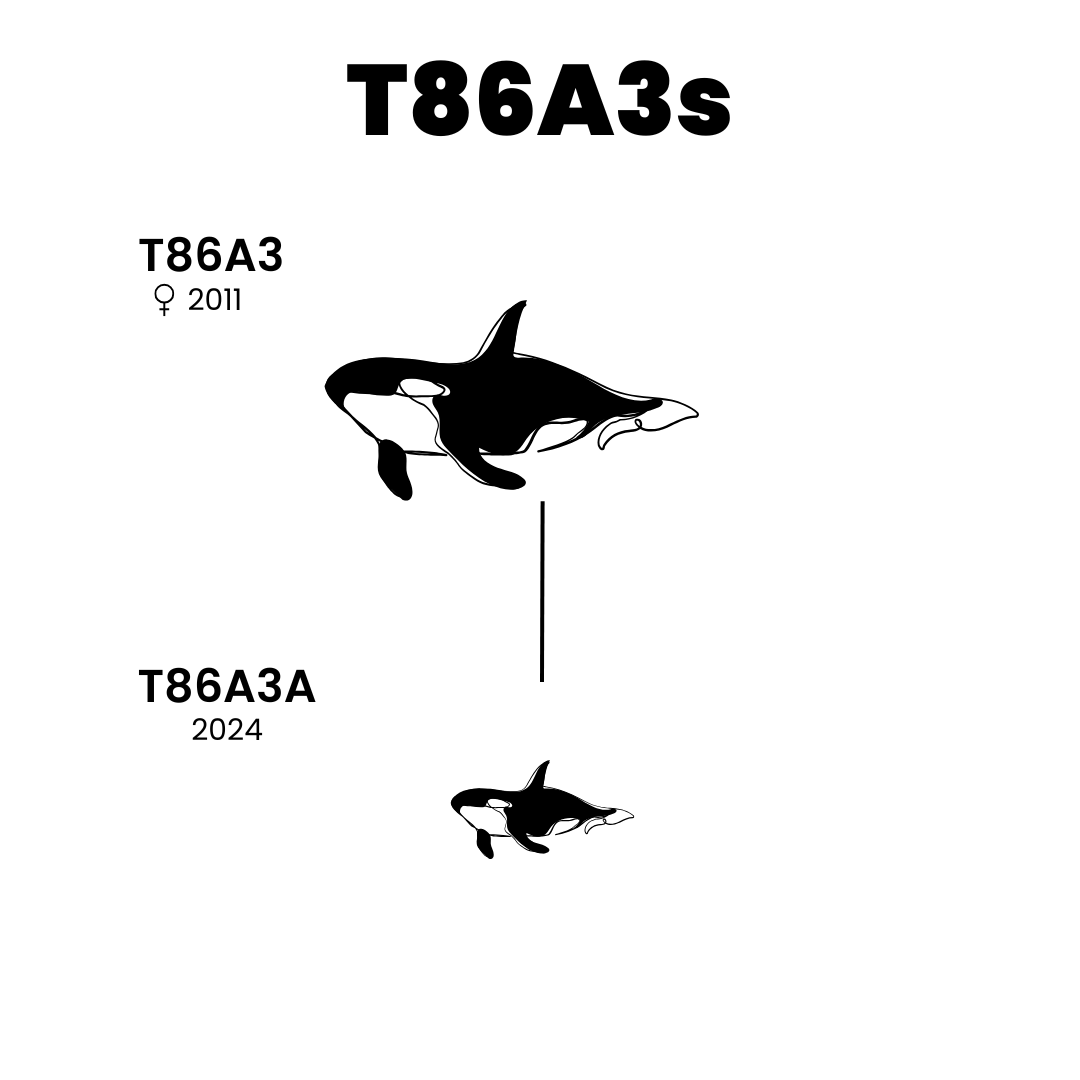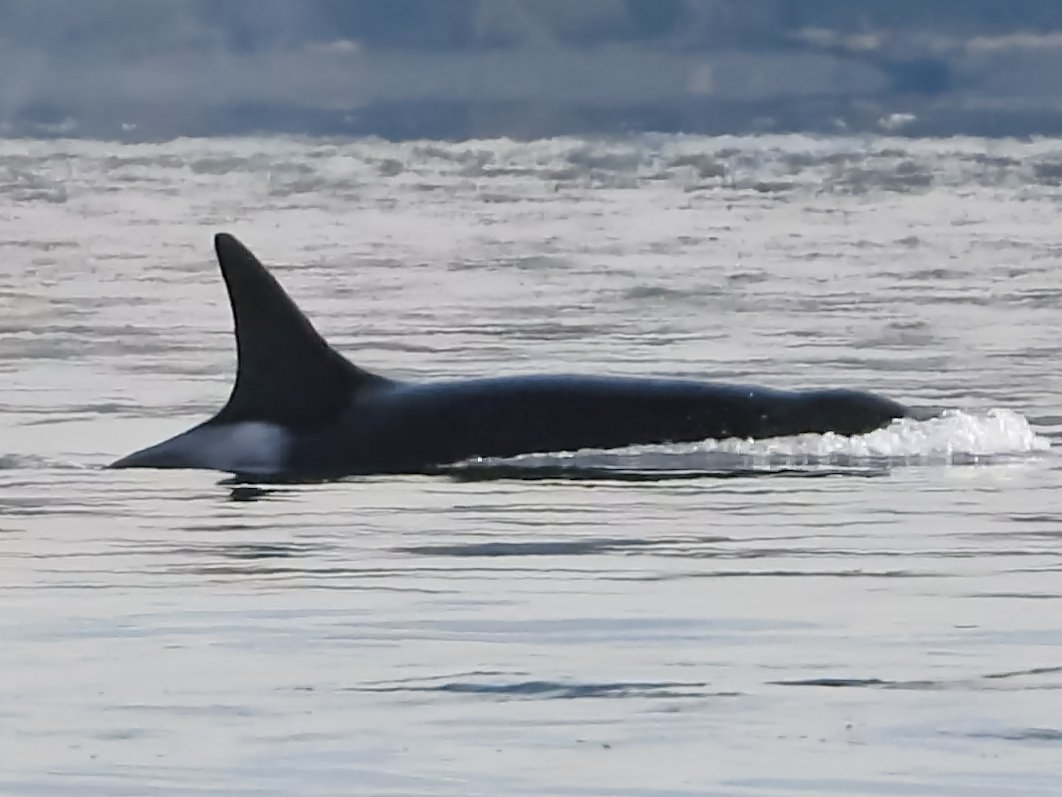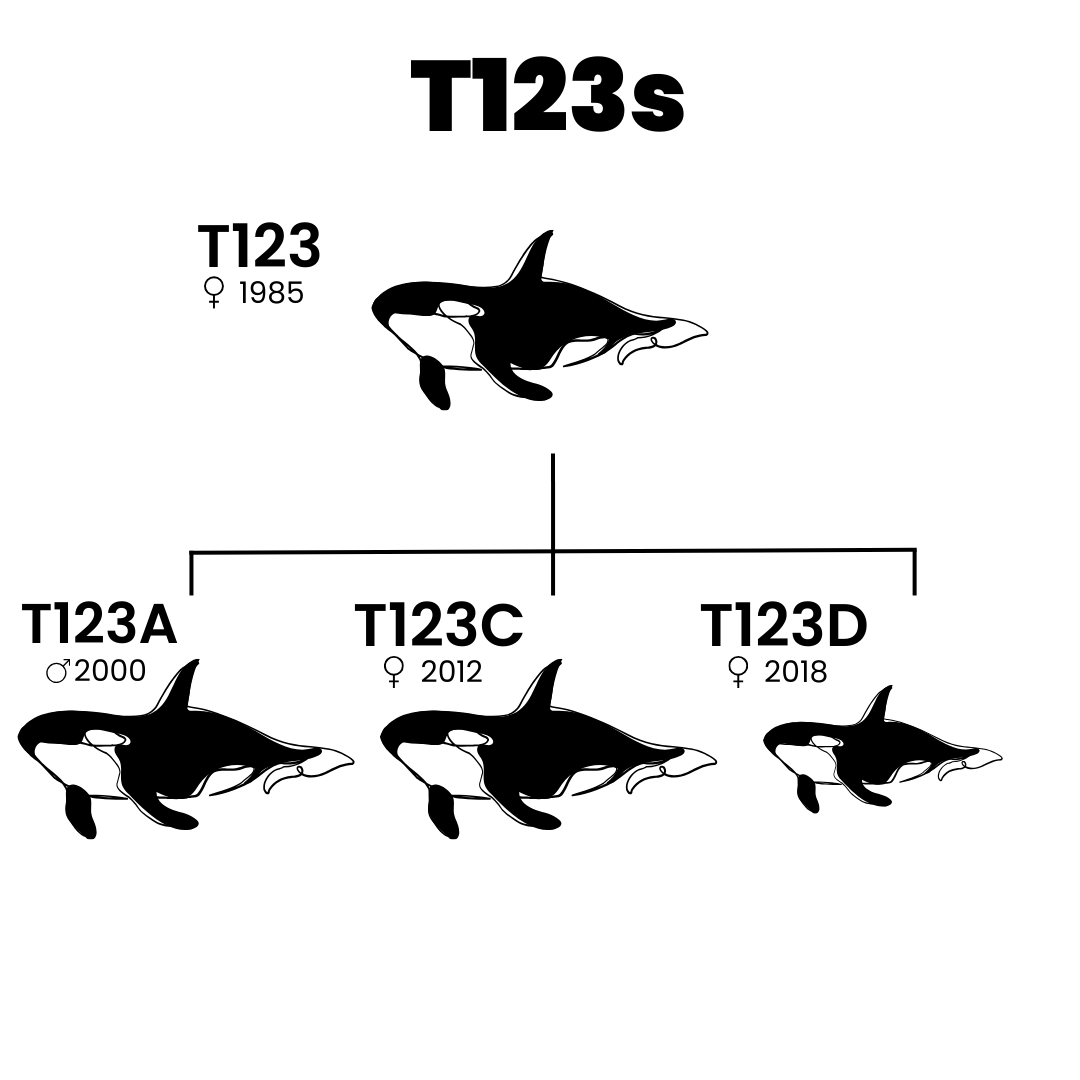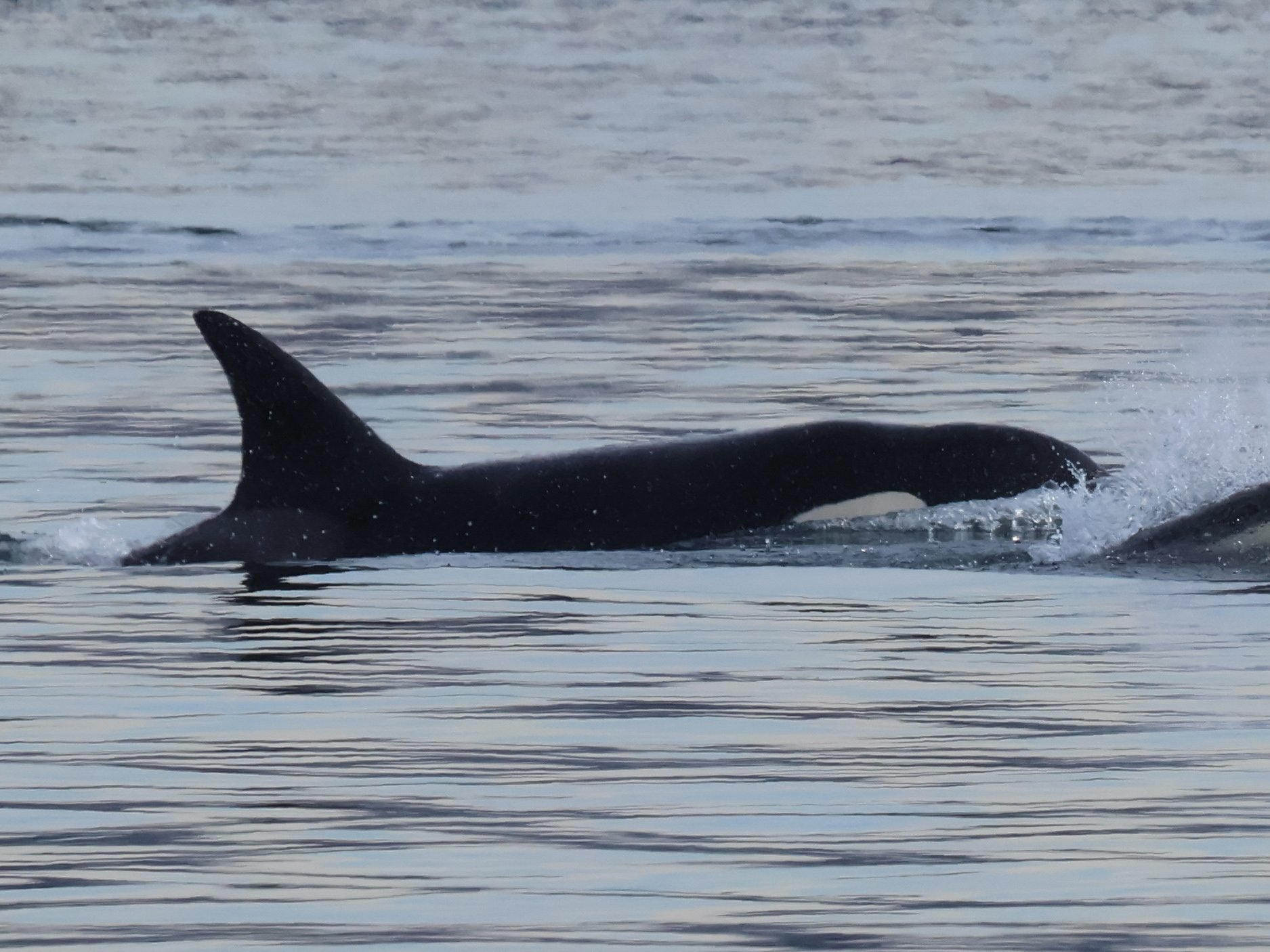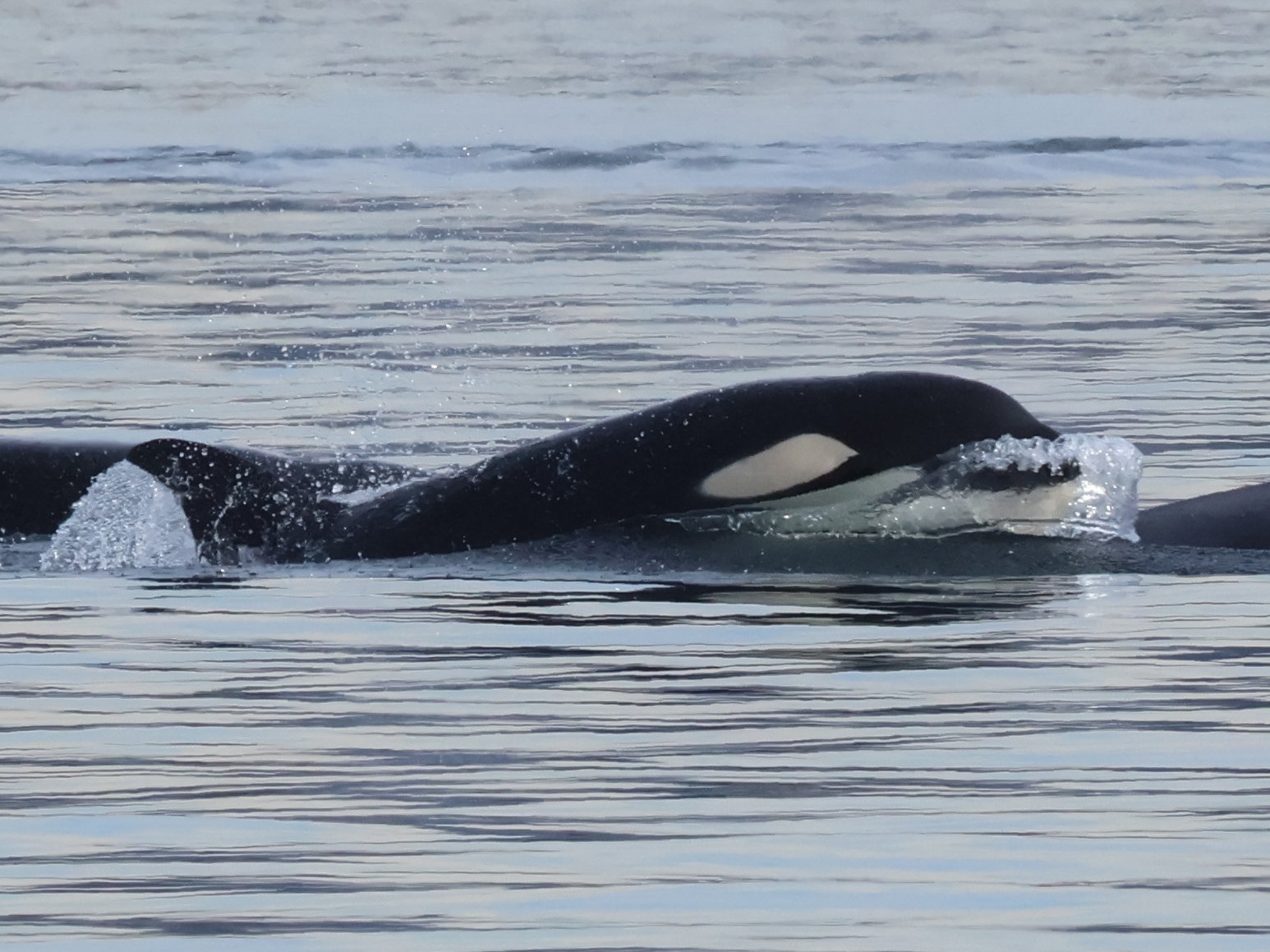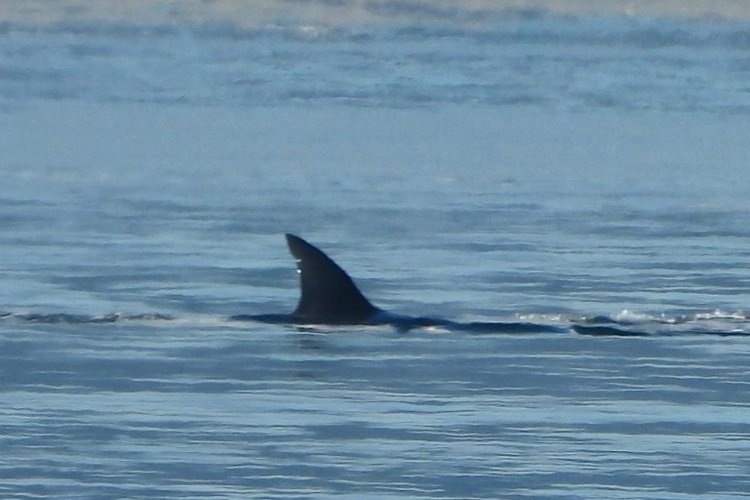
Meet the Transient Killer Whales
Who are the Transients?
Transient killer whales, also known as Bigg’s killer whales are a genetically and culturally distinct population or ecotype of orcas within the Pacific Northwest and prey exclusively on marine mammals. The name “transient” came from killer whale Researcher Dr. Michael Bigg who observed their behavior as transient or more nomadic. Later, transients also became to be known as Bigg’s, which was in honor of the belated killer whale researcher who first began the identification and cataloging of orcas, determining the different ecotypes.
When Dr. Bigg began his studies transients were far more elusive than Residents and seemed to have less predictive travel behaviors. Since that time, there has been a steadily growing presence of transients within the Salish Sea due to a flourishing food source, which has allowed us to observe that the prenotion of the “transient” behavior is actually not the case. Instead, multiple matrilines appear to have seasonal and location preferences. For example, the T65As spend much of the summer in Puget Sound proper, while the T18s show up in the northern Salish Sea during late summer and early fall.
Like other ecotypes of orcas, Bigg’s orcas are matriarchal, which means females are the leaders. Similar to their Resident cousins, there are separate family sub-groups or matrilines that are centered around the mothers or grandmothers. However, unlike Residents, transients spend most of their time traveling in smaller groups of immediate family, averaging about 3 to 7 individuals to optimize hunting and prey sharing.
Transients often get the reputation for being “outcasts” or solo creatures. And while there are some instances of orphaned or single orcas observed alone, the majority of the transient population is incredibly social. Extended families and other matrilines will often meet up and travel together for short to long periods of time to socialize or breed. It has been observed that when multiple pods of transients are together, young calves will play, while mothers will spend time with one another. There have even been cases where individuals from one matriline will break away from their mother and spend time with aunts and cousins, to return to their mother later on.
With the increasing amount of prey within the Salish Sea, we are beginning to see record numbers of Bigg’s killer whales in our waters, which allows us the opportunity to learn even more about this once mysterious and illusive ecotype.
Diet
Transient orcas feed exclusively on marine mammals such as seals, sea lions, porpoises, dolphins, and whales. Their diet defines their culture, lifestyle, and travel patterns.
Transients are far less vocal than their Resident cousins, which allows them to be stealthy and ambush their prey. Instead of regularly using echolocation, which could risk tipping off an alert seal of their presence, transients will use passive listening to remain undetected, occasionally using echolocation to create a quick snapshot of where prey may be located.
Since transients prey share similarly to Residents, it is necessary for them to travel in smaller groups. Having a smaller group makes it more efficient to both hunt but also share prey. An average adult killer whale requires up to an estimated 350 lbs of food. A pod of 4 Bigg’s orcas may need upwards of 1,400 lbs of food in a single day, which could amount to about 7 adult harbor seals weighing 190 lbs. The larger the matriline, the more food it will require, which makes smaller groups far more efficient. (Please note numbers are not exact and are rough calculations to depict the dietary need of transients.)
Matrilines & Identification
Each matriline is identified by the eldest female within the group and given an alphanumeric ID beginning with the letter T (to denote the transient population). Each member within the matriline will be assigned an alternating alphanumeric ID based on birth order, letters and numbers will alternate as new generations are born.
In most cases, males will spend the entirety of their lives with their mother (and maternal grandmother if she is still alive). However, female orcas will break away and form a new matriline once they begin to have calves of their own to keep pod sizes small. Once a female and her calves begin to travel separate from the rest of their family, they become identified as a new matriline.
For example, T65 had two female calves who received the alphanumeric IDs of T65A and T65B. Once T65A began to have her own calves, she broke off into a new matriline now called the T65As. Her calves all have IDs beginning with T65A followed by a number assigned in birth order. T65A’s eldest offspring is T65A2, followed by offspring T65A3, and so on. When T65B began to have her own calves and travel with them separately from her extended family, her matriline was identified as the T65Bs.
While the alternating alphanumeric is the identification technique for the majority of the Bigg’s population, there are some variations in numbering. This is the case when a relation wasn’t known when the orca or matriline was first discovered. An example of numerical variation is the T18s, which also include the T19s.
As the transients have become more prevalent in the waters of the Salish Sea, many will come to recognize them by nicknames. The nicknames are usually assigned to an individual by the person who first identified or cataloged them. Generally, the nicknames come from the locations they were discovered, but there are many others who received names from folklore, First Nations languages, in honor of people, characteristics, and more.
Download the free Bigg’s Photo-Identification Catalog by Canada Department of Fisheries and Oceans.
Please note, there are over 350 individual Bigg’s killer whales cataloged. While our goal is to eventually feature all the unique individuals on this page, that will require ongoing work. Our current catalog will be based on the matrilines who spend the most time within the Salish Sea, as well as the matrilines we have encountered. We will continue to build our catalog as we go, so keep checking back for updated information.
©All photos and content belong to Orca Conservancy unless otherwise stated.
T2Cs
T2C Tasu (female, born 1989)
T2C is the matriarch of the T2C matriline and has had a total of 5 confirmed offspring, 3 of which are alive today. One of her calves was born with a spine condition called scoliosis. Her family line has had other genetic issues including her sister T4 (captured in 1970 and died in 1972 at Sealand of the Pacific) who had Chediak-Higashi Syndrome which causes leucism. The nickname Tasu is from Tasu Sound.
T2C1 Rocky (male, born 2002)
T2C1 is a fully sprouted male and the first calf to T2C. During the time his younger brother T2C2 was alive, T2C would assist his mother in the care of T2C2 who had a spinal condition called scoliosis. T2C1 and his mother would hunt and kill prey, then bring it back to T2C2 and share with him. The nickname Rocky is named for Rocky Point located near Victoria, B.C., Canada.
T2C3 Lucy (female, born 2011)
T2C3 is the third calf born to T2C and was determined to be female. Her nickname Lucy follows the theme of her mother and is from Lucy Island off the north end of Haida Gwaii which is an archipelago off the coast of British Columbia, Canada. She also has the nickname, Helena.
T2C5 (sex unknown, born 2020)
T2C5 is the second youngest calf born to T2C. Currently, the sex is unknown for this young whale, and it has yet to receive an official nickname.
T2C6 (sex unknown, born 2025)
T2C5 is the youngest calf born to T2C, and was first documented in February 2025. Currently, the sex is unknown for this young whale, and it has yet to receive an official nickname.
Previous Members:
T2C4 Kano (sex unknown, born 2017) - Presumed deceased
T2C2 Tumbo (male, 2005 - 2020)
T2C2, nicknamed Tumbo was a sprouted male that had scoliosis which caused his spine to curve resulting in a wavy-shaped dorsal fin. During his life, his condition made it so he would often not actively participate in hunts. After killing prey, his family would bring him food and share with him. In 2019 it was noted that T2C2 was missing, and he was declared deceased in 2020.
T11A
T11A Rainy (male, born 1978)
T11A is a lone male and the only offspring to T11 Wakan (presumed deceased), who went missing in 2020. T11A is roughly around 47 years old, making him one of the older lone males documented in the population. Typically, male orcas spend the entirety of their lives with their mothers, and in many cases do not survive long without their mother or matriarch. He often associates with the T46Bs, as well as T46C2, a lone female related to the 46Bs. T11A also holds the record for being one of the largest Transient killer whales documented in the Northeastern Pacific Coastal Bigg’s population, measuring a total of 27ft (8.2 meters).
T18 & T19s
T18 Esperanza (female, born ≤ 1955)
Esperanza is the matriarch (mother and grandmother of the T18s/T19s. Her nickname comes from Esperanza Inlet off the northwest end of Vancouver Island. T18 is currently missing and has not been seen since August 2024.
T19 Nootka (female, born ≤ 1965)
The name Nootka is believed to have come from Nootka Sound. She also has the nickname Mooyah, which is named for Mooyah Bay in Nootka Sound.
T19B Galiano (male, born 1996)
Galiano is easily recognized by his wide dorsal fin that leans to the left and creates the illusion that it is short and stubby when viewed from the side. Galiano receives his nickname from a geographic location, Galiano Bay in Nootka Sound, which is fitting since his mother was named for the same area. He also has the nickname Kosatka.
T19C Spouter (male, born 2001)
Spouter is the youngest of the two calves born to T19 and seems to have a close bond with his older brother. Like his brother, his name comes from a location in Nootka Sound and is named after Spouter Island.
T34s
T34 Grace (female, born ≤1969)
T34 is the matriarch of the T34s and has two confirmed offspring, as well as one presumed offspring, T37 who is a member of a separate matriline. The name Grace was chosen by a killer whale biologist in honor of her grandmother who was a teacher and inspiration.
T34A Pachamama (female, born 2007)
T34A is the first confirmed calf to T34 and has one confirmed sibling and one presumed sibling. She gave birth to her first and thus far only calf in 2019. The name Pachamama is of the Indigenous people of the Andes, and means Mother Earth.
T34B Sonder (female, born 2017)
T34B is a female and the second confirmed calf of T34. Her name Sonder was chosen for its philosophical significance which means, “the realization that each random passerby is living a life as vivid and complex as your own.”
Previous Members:
T34A1 (sex unknown, 2019-2024)
T34A1 was the first and only calf born to T34A and was the grandchild of T34. During its life, T34A1 did not travel with its mother but instead was often seen with the T36s, which have no known relation. T34A1 was last seen in the summer of 2022 and was declared deceased in 2024. It was estimated to be around 4 years old. The sex was never determined and the young whale did not receive a nickname prior to its death.
T35 & T35As
T35A Lester (female, born 1998)
T35A is a female born in 1998. She can be easily identified by her dorsal fin which has a prominent crescent shape, with a small nick off the back tip. She travels with her four offspring, and frequently associates with her presumed sister T38A and her offspring. Her nickname Lester is for Lester Island located in Glacier Bay, Alaska.
T35A1 Opal (female, born 2010)
T35A1 is the first offspring of T35A, born in 2010. She was confirmed to be female. Her nickname Opal is after the gemstone. She has a crescent-shaped dorsal fin, that is slightly thinner than makes her easy to identify.
T35A2 Topaz (sex unknown, born 2013)
T35A2 is the second offspring of T35A and was born in 2013. The sex has yet to be determined. The nickname Topaz is after the gemstone and keeps with the naming theme of its siblings. It has a short and slightly wide dorsal fin in a prominent crescent shape that is slightly thinner than her siblings.
T35A3 Garnet (sex unknown, born 2018)
T35A3 is the third offspring of T35A and was born in 2018. The sex has yet to be determined. The nickname Garnet is after the gemstone, and keeps with the gemstone naming theme of its siblings.
T35A4 Agate (sex unknown, born 2022)
T35A4 is the youngest calf of T35A and was born in 2022. The sex of the calf is currently unknown. T35A4 was given the name Agate after Agate Pass in Puget Sound, and also in keeping with the gemstone naming theme of its family.
T35 Ruby Roo (female, born ≤1970)
T35 is a female estimated to have been born sometime after 1970. She is confirmed to be the mother of T35A, and is presumed to be the mother of T38. She has four confirmed grandchildren, five presumed grandchildren, and two presumed grandchildren. T35 has not been documented or seen with her family since 2020.
T36 & T36Bs
T36 Flapjack (female, born ≤ 1970)
T36 Flapjack is the matriline of the T36s and has 2 confirmed surviving offspring (her third confirmed offspring, T36C, is deceased). T36 is also presumed to be the mother of two additional whales, T137 and T99, both of which have their own matrilines. The nickname Flapjack comes from an island in Glacier Bay that is a popular hunting spot amongst transients.
T36B Tattertip (female, born 1998)
T36B is the second offspring to T36 and is the mother to three calves. Unlike her sister T36A, T36B remains with her mother who is the matriarch of this matriline and assists in the care of the three calves. The name Tattertip follows the naming convention of her mother and is from an island in Glacier Bay that is famous for its abundance of harbor porpoises.
T36B1 Bhotia (female, born 2009)
T36B1 is the first calf born to T36B and was confirmed to be female. The nickname Bhotia which means teacher, which is fitting as she is the eldest of her sibblings.
T36B2 Greenfelder (sex unknown, born 2013)
T36B2 is the second calf born to T36B. The sex of this orca has yet to be determined. T36B2 received the nickname Greenfelder, named for professional wildlife photographer Mike Greenfelder.
T36B4 Auk (male, born 2024)
T36B4 is the newest calf born to T36B. He was first seen by researchers in February 2024. In July of 2024, local whale watchers photographed images of T36B4 breaching and were able to confirm he is a male based on the markings of his underside. His slim and pointed eye patches have been said to look like an auk (type of sea bird), which inspired his nickname.
T36B1A Maple (female, born 2025)
T36B1A was first seen in January 2025 and is the first calf born to T36B1 Bhotia. T36B1A was determined to be female when local whale watchers captured photographs of her underside, when she rolled upside down, swimming under the Fox Island bridge in March 2025. She was given the official nickname Maple to honor the 352-year-old Maple tree at English Camp on San Juan Island. The name Maple also keeps with the naming theme of her grandmother, “Flapjack”.
Previous Members:
T36B3 Chip (male, 2018-2024)
T36B3 was the second youngest calf to T36B and was confirmed to be a male. His nickname, Chip, is from a character from Disney’s Beauty and the Beast because of the small nick he had in the middle of his dorsal fin. We first saw T36B3 in 2019 when he was just a year old, and he was full of energy, racing away from the family to play on his own only to come right back and play with mom, his siblings, and his presumed cousins. Chip has not been documented with his family since the summer of 2023 and was declared deceased in 2024.
T36As
T36A Leland (female, born 1990)
T36A is the matriarch of the T36s and has had a total of 5 offspring, 4 of which are alive today. She travels with her 4 children and grandchild. She also has the alphanumeric designation AM35. The name Leland is from an island near Flapjack (who who mother is named for) in Glacier Bay.
T36A1 Tierna (female, born 2005)
T36A1 is the first born offspring to T36A. She became a first time mother in 2022 when she was seen with a young calf designated T36A1A. The name Tierna means Earth. She can be easily recognized by the curved and thin notch at the lower center of her dorsal fin.
T36A2 Kailas (female, born 2012)
T36A2 is the second calf born to T36A. The nickname Kailas is after a spiritual mountain in the Himalayas. In the summer of 2023 T36A2 was observed with a new nick at the tip of her dorsal fin, which is not depicted in the official ID guide.
T36A3 Storm (male, born 2015)
T36A3 is a male and the third calf born to T36A. He was given the nickname Storm for the marking on the left saddle patch that resembles a lightning bolt. During our encounter with the T36As he was observed traveling and playing with his siblings and young niece/nephew.
T36A5 Squall (male, born 2021)
T36A5 is the fifth calf born to T36A and is one of the four surviving offspring. T36A5 was first seen in 2021. In 2024 whale watchers got a photo of T36A5 breaching and were able to determine him to be a male. He was given the nickname Squall, which is a sudden increase in wind spead and often associated with thunderstorms, keeping with the naming theme of his family. Squall is also a nod to his saddle patch which has a cyclone shape. He and his nephew are close in age, and the two often travel and play together.
T36A1A Drift (male, born 2022)
T36A1A was first seen in 2022 and is the first calf born to T36A1. T36A1A was confirmed male by local naturalists. He was given the nickname Drift, which refers to the intrinsic movement of elements in some cultures. T36A1A travels with its mom, grandmother, aunts, and uncles. His uncle was born the year prior, and the two have a close relationship and can often be seen playing together.
T37 & T37Bs
T37 Rocky III (female, born 1979)
T37 is the mother of two surviving offspring, and is the matrairch of the T37/37Bs. T37 travels with her youngest daughter and her grandchild.
The nickname Rocky III is based on the fact that she is the third known orca to receive the nickname Rocky (one previous orca in B.C., the other in New Zealand). The name Rocky is for the fact that Bigg’s killer whales are often seen hunting close to shore and rocky bluffs.
T37B Harald (female, born 1998)
T37B is the third calf born to T37, and is one of the two surviving offspring. She had a total of two calves, one of which (T37B2) has gone missing and is now presumed as deceased.
T37B received the nickname Harald in honor of Harald York, an acoustics researcher.
T37B1 Lance (male, born 20212)
T37B1 is a male and is the firstborn offspring of T37B. He travels with his mother, T37B, and grandmother T37. The nickname Lance is in honor of the Canadian killer whale genetics researcher Lance Barrett-Lennard. He has a unique saddle patch that appears to be fully open on the right side, which is a characteristic not typically seen in the Northeastern Pacific Coastal Bigg’s population.
Previous Members:
T37A2 Trident (sex unknown, born 2017)
T37B2, nicknamed Trident, is the second calf born to T37B. T37B2 went missing in 2021, and was presumed deceased by researchers in July 2022.
T37As
T37A Volker (female, born 1994)
T37A, nicknamed Volker is a female orca born in 1994. She is the matriarch of the T37As. She has had a total of 5 offspring and travels with all but her eldest daughter. She has a single notch in the center back edge of her dorsal fin, similar to that of one of her offspring. Volker is after a transient acoustic researcher, Volker Deecke.
T37A2 Inky (male, born 2009)
T37A2 is a sprouting male nicknamed Inky, and the second offspring born to T35. Like his mother, he has a notch in the center back edge of his dorsal, but can be easily distinguished from her because of his sprouting dorsal fin that is taller in comparison, and has a small nick at the back base at the base on the edge of his saddle patch.
T37A3 Spinnaker (male, born 2013)
T37A3 is a male and the third offspring born to T37A. He seems to have a close bond with his older brother T37A2. He is easy to distinguish from his family as he has a narrow, crescent shaped dorsal fin that lacks any notches, unlike his older siblings and mother. The right side saddle patch is said to resemble a spinnaker, which is a type of sail, which is where he gets the nickname Spinnaker.
T37A4 Crinkle (male, born 2015)
T37A4 is a male and fourth offspring of T37A. He is quite easy to identify amongst his family because of the unique shape of his dorsal fin which appears smooshed or crinkled. His dorsal fin is where he gets the nickname Crinkle.
T37A1 Inyo (female, born 2007)
T37A1 is a female and the first offspring born to T37A. She does not typically travel with her mother or siblings. She can be easily identified by the two notches at the upper back edge of her dorsal fin, and a small nick toward the base. The nickname Inyo comes from Inyo County in California.
Previous Members:
T37A5 Jib (male, born 2019-2024)
T37A5 was a male and formerly the youngest offspring born to T37A. Keeping with the sailing theme of one of his older brothers, his nickname, Jib, is after a triangular sail. He has not been photographed or seen with his family since 2022. He was declared deceased in 2024 and was estimated to be 4 years old.
T38As
T38A Dana (female, born 2000)
T38A is a female born in 2000 and is the presumed granddaughter of T35. She has had a total of 2 offspring, one of which is still alive today. She travels with her surviving calf and often associates with her presumed sister T35A and her offspring. She has a late white pigmented marking on the front, left side of her dorsal fin that makes her easy to identify. Interestingly, her sibling T38C has a similar white marking on the right side of its dorsal fin.
T38A2 (Sex unknown, born 2020)
T38A2 is the second offspring born to T38A. The sex is currently unknown, and it has yet to be assigned a nickname. The T38As often associate with the T35As (presumed to be related), and T38A2 has a close connection with its second cousins who are close in age.
T38A3 (Sex unknown, born 2024)
T38A2 is the third calf born to T38A, and one of two surviving offspring. The sex is currently unknown, and it has yet to receive an official nickname.
Previous Members:
T36A1 (sex unknown, 2015-2021)
T38A1 is the first offspring of T38A and was born in 2015. It was last documented in and photographed in 2018, and designated deceased by researchers in 2021. It was estimated to have been around 6 years old when it died. The sex was never known, and it was not given a nickname,
T46s
T122 Centeki (female, born ≤ 1992)
T122 is a female orca and presumed offspring of T46. It is possible that she is the sister of T46. She was originally given the alphanumeric ID of T46A, but it was later changed after she separated from the T46s for 13 years before rejoining them again. The name Centeki Coast Salish is for one of the 13 lunar phases.
T46D Strider (male, born 2000)
T46D is a fully sprouted male easily recognized by his uniquely shaped dorsal fin that has two triangular notches missing out of the top. From some angles the dorsal fin top appears to be flat. T46D can sometimes be mistaken for T63 Chainsaw. The name Strider is a reference to the character Aragorn from Lord of the Rings by J.R.R. Tolkien.
T46E Thor (male, born 2003)
T46E is one of many calves born to T46 and is a fully sprouted male. He is easily recognized by his tall dorsal fin that has a distinct bend and a notch at the center back. His dorsal fin is said to resemble a lightning bold, which led to the nickname Thor, after the Norse god of thunder, sky and agriculture.
T46F Loki (male, born 2012)
T46F is a male and the youngest calf born to T46. Following the naming theme of his older brother T46E Thor, 46F was named Loki after the Norse god of mischief and trickery.
Previous Members:
T46 Wake (female ≤ 1966-2023)
T46 was the matriarch of the T46s and one of the most successful mothers with 8 total presumed offspring, 15 possible grand calves, and 5 possible great-grand calves. T46 was one of the Budd Inlet Six, a group of 6 transient killer whales that were captured in 1976 in held in Budd Inlet to be sold off to aquariums. After a local politician observed this and public outrage, the whales were released, and legislation was passed that led to the end of cetacean capture in Washington and US waters. T46 went missing in the Spring of 2023, and is presumed deceased.
T46Bs
T46B Raksha (female, born 1988)
T46B is the matriarch of the T46Bs and is a very successful mother, having had a total of 7 calves, 6 of which are alive today. In December 2016 the first observed case of infanticide was documented in the transient populations of a post-reproductive female T68 and her fully matured son T68A attacked and killed the calf of T46B, T46B5 (sex unknown b. 2015). T46B’s nickname Raksha, which is Sanskrit for “protection”, was chosen for her valiant effort to save her calf during the attack.
T46B2 Akela (male, born 2008)
T46B2 is the second calf born to T46B and is a confirmed female. She had her first calf in 2021, and the two still travel with the T46Bs. Her nickname Akela is Hebrew for happy or blessed, and is also a wolf character in Jungle Book, which is a nod to her mother’s name Raksha, which is also a wolf in The Jungle Book.
T46B3 Sedna (female, born 2011)
T46B3 is the third calf born to T46B and is a female. She was given the nickname Sedna, which in Inuit mythology is the goddess of the sea and marine animals.
T46B4 Quiver (male, born 2013)
T46B4 was the fourth calf born to T46B and confirmed to be male. During the infanticide event in 2016, researchers documented fresh teeth rake mark wounds, and a kink on the ridge of his back, indicating he had been attacked prior to their arrival. Fortunately, T46B4 was able to survive the attack. On the right saddle patch, there is scaring that resembles the shape of an arrow within a quiver, which lead to his nickname Quiver.
T46B6 Sol (female, born 2019)
T46B6 was the first calf born to T46B after the infanticide event in 2016. She was given the name Sol, which means sun, in contrast to her nephew T46B1B (deceased) named Tl’uk (which means moon), who was born the year prior.
T46B7 Tala (sex unknown, born 2023)
T46B7 is the seventh calf born to T46B and was first documented in April 2023. The sex of this calf is not yet known. 46B7 was given the nickname Tala, which means “wolf” in multiple North American Indigenous languages, and it also means “star” in Tagalog (language spoken in the Philippines), which keeps with both the wolf and celestial naming theme of the family.
T46B2B Takaya (sex unknown, born 2023)
T46B2B was first seen by a whale watching tour on November 26, 2023. It is the second calf born to T46B2. The sex of this calf is not yet known. It was given the nickname Takaya which is the Lekwungen Coast Salish word for wolf and name for a famous sea wolf, keeping with the wolf naming theme of the family.
T46B3A (sex unknown, born 2025)
T46B3A was first seen in March 2025 and is the first calf born to T46B3. This young calf is one out of an estimated 16 great-grand-calves to T46 Wake (deceased), who was captured for captivity in 1976 before ultimately being released, and becoming one of the most successful mothers. The sex of T46B3a is not yet known, and it has yet to receive an official nickname.
Previous Members:
T46B5 (sex unknown, 2015-2016)
T46B5 was the first and only documented infanticide case within the transient/Bigg’s killer whale population in the North Pacific.
T46B2A (sex unknown, 2021-2022)
T46B2A was the first calf born to T46B2. The sex of this calf was never determined. It was last seen in 2021 and determined to be deceased in 2022.
T46B1s
T46B1 Tread (female, born 2003)
T46B1 is the matriarch of the T46B1s and has had a total of 3 calves, 2 of which are alive today. She was around the age of 12 when she had her first calf T46B1A. Her second calf, T46B1B (deceased), was leucistic which causes the loss of coloration, resulting in the skin color appearing white and grey. The nickname Tread is from the markings on her left saddle patch that resemble tire tread patterns.
T46B1A Tsakani (female, born 2015)
T46B1A is the first calf born to T46B1 and is a female. Both her and her mother were present in the 2016 infanticide attack where she lost her relative, T46B5, who was the same age as her at the time. During the incident, researchers captured a photograph of T68A (one of the attacking whales) surrounded by T46B1A (who was only 1 year old) and her mother. Thet name Tsakani is the Xistonga word that translates to “be happy”, and follows the T letter naming convention as her mother.
T46B1C Tide (male, born 2022)
T46B1C is the youngest calf born to T46B and was confirmed to be male. He was born after the loss of his late older brother T46B1B Tl’uk (meaning moon), a leucistic whale that made him appear white. The nickname Tide was chosen to honor Tl’uk, because of the symbolism of the moon ruling the tides, and also represents the gravitational pull felt to family lost before us.
Previous Members:
T46B1B Tl’uk (male, 2018-2020) - Presumed deceased
T46B1B was the second calf born to T46B in 2018, and at only two years of age went missing in 2020 and is now presumed to be deceased. He was confirmed to be male and was famous for his light-grey and white coloration that was a result of his condition of leucism which causes the loss of pigment. Some experts believe this condition may have been a contributing factor or cause of his likely death. Researchers also believe that T46B1B may have been a difficult birth due to the killer whale teeth rake marks on both sides of his saddle, suggesting other whales may have aided in pulling him out. The name Tl’luk, which means moon in Bella Coola Coast Salish, was chosen for his light grey and white coloration.
T46Cs
T46C Carmanah (female, born 1994)
T46C is the matriarch of the T46C matriline and has 4 offspring, three of which travel with her. The nickname Carmanah is from the Carmanah Walbran Provincial Park on the southwest end of Vancouver Island, located in Ditidaht First Nation (diiɁdiitid) territory. An interesting ID note about T46C is that her left and right eye patches vary significantly in shape.
T46C1 Tsunami (male, born 2006)
T46C1 is the first calf born to T46C and is a fully matured male with a tall dorsal fin that can be easily identified by the two notches in the mid to lower trailing back edge. The nickname Tsunami is after the catastrophic ocean wave that is caused by earthquakes.
T46C3 Razor (sex unknown, born 2013)
T46C3 is the third calf born to T46C and is not known if it is a male or a female. 46C3 is easily identified by its dorsal fin which has two jagged notches at the top trailing back edge that resembles a razor blade. The notches on the dorsal fin lead to the nickname of Razor.
T46C4 Hobi (sex unknown, born 2018)
T46C4 is the fourth and youngest calf born to T46C. The sex is not yet known. The nickname Hobi follows the naming pattern of its mother, T46C, and comes from Hobiton Lake near Carmanah which T46C is named for.
T46C2 Sam (female, born 2009)
T46C2 is the second calf born to T46C and currently does not travel with the T46Cs. In 2013 when she would have been around 4 years old, T46C2 became separated from her family and was stranded in a small cove near Aristazabal Island on the North Coast of British Columbia, Canada. Scientists and the Vancouver Aquarium monitored T46C2 for several weeks before intervening when it became clear the young whale would not leave on her own and was showing physical signs of distress and malnutrition. Researchers attempted to lure the young orca out of the bay with transient calls played on an underwater speaker, but T46C2 appeared to be afraid to pass through the shallow entrance of the Bay. Researchers then used a floating line between two boats to herd T46C2 towards the bay opening, while a third boat at the outside of the bay played transient calls. Upon the first attempt, researchers were successful in moving T46C2 out of the bay. Two years after the stranding event, she was sighted with the rest of her family and appeared healthy. The nickname Sam was given to T46C2 by the researchers involved with her rescue and release.
T49As
T49A Nan (female, born 1986)
T49A is the matriarch of the T49As and has a total of 6 offspring, all of which are still alive. She has the additional alphanumeric designation of AL12. Her nickname Nan is short for Nanaimo, a city located on Vancouver Island.
T49A1 Noah (male, born 2001)
T49A1 is a the first offspring born to T49A, and is a fully sprouted male. Unlike his younger brother, he travels with his mother and the rest of his younger siblings. His nickname is a biblical reference linking the great flood with the chaotic nature of the ocean.
T49A2 Jude (male, born 2007)
T49A2 is the second offspring born to T49A2. He does not usually travel with his family and often associates with his uncle T49C, other lone males, and males his age. In August 2023 T49A2 became trapped in a saltwater lake in Alaska with T51 and was guided out by responders in late September. He is easily identified by his sprouting dorsal fin that leans to the right.
T49A3 Nat (male, born 2011)
T49A3 is a male born in 2011 and is the third offspring born to T49A. His nickname is after a member of the community in Glacier, Alaska, and keeps consistent with the N naming theme of the family.
T49A4 Neptune (male, born 2014)
T49A4 is a male born in 2014, and is the fourth son of T49A. The nickname Neptune keeps with the N naming theme of his family, and is after the Roman God of water.
T49A5 Nebula (female, born 2017)
T49A5 is a female born in 2017, and is the only female born to T49A. Her other 5 siblings are all males. Her nickname Nebula keeps with the N naming theme of her family, and is a reference to her unique eyepatch on the leftside that has black markings on it.
T49A6 Charlie II (male, born 2022)
T49A6 is the youngest calf born to T49A, and was born in 2022. He was determined to be a male in the spring of 2024. When 49A6 was first documented, he did not have any disfigurations, however in August 2022 he was photographed with a prominent underbite making him quite easy to identify. Given that he was not born with the underbite, is likely caused by an injury. The nickname Charlie II is after T1 Charlie Chin (deceased) who also had an underbite.
T49C
T49C Neilson (male, born 1998)
T49C is a lone male who was born in 1996. He is easily identified by his tall, fully sprouted dorsal fin that has two small notches in the center back edge. He has two surviving siblings, his sisters T49A and T49B. He often associates with his nephew T49A2, and they seem to have a close bond. He was initially given the nickname Janet, after a humpback whale researcher named Janet Neilson, but this was eventually changed to Neilson because he is a male.
T51
T51 Roswell (male, born ∼1981)
T51 is a lone male whose lineage is unknown. He used to travel with another male of unknown relation, T48 (deceased). T51 is known to travel with multiple different matrilines, including the T36As and the T99s, and has also been known to travel with other lone males as well. In August 2023, T51, along with T49A,2 entered a saltwater lake on Prince of Wales Island in Alaska and became trapped for a total of 6 weeks. The two were guided out of the lake by a response team (DFO, NOAA, Orca Conservancy, and local citizens) using playback calls through a narrow channel. The nickname Roswell is a nod to the alphanumeric number T051 and is a reference to Area 51. He also has the nickname Loner. Since the Barnes Lake response incident, T51 has been seen multiple times in good health. On April 22, 2025, he was documented 2 miles up the Siuslaw River in Florence, Oregon.
T60s
T60 Panthera (female, born ~1980)
T60 is the matriarch of the T60s and has had a total of 7 offspring, 5 of which are still alive. She travels with 3 of her offspring, her oldest son T60C, and her two youngest calves T60F and G. The name Panthera is a reference to the genus of big cats, as her left saddle has rake marks that resemble a cat scratch.
T60C Yelnats (male, born 2001)
T60C is the oldest surviving offspring of T60 and is a fully sprouted adult male. He was given the name Yelnats, which is Stanley spelled backward, as he is considered the doppelgänger to T123A (named Stanley) because they both have a similarly shaped dorsal fin with a nearly identical notch in the same spot. The name Yelnats is also a nod to the character Stanley Yelnats from the book and film Holes.
T60D Onca (male, born 2004)
T60D is the second surviving offspring of T60, and is a maturing male who is beginning to have a sprouting dorsal fin. He does not often travel with his family, but instead travels with his younger brother T60E. The nickname Onca follows the feline naming theme of this mother, and is the scientific name for jaguars.
T60E Lynx (male, born 2008)
T60E is the third surviving offspring born to T60, and travels with his older brother T60C. He is easily identified by his pointy dorsal fin that has a large nick at the top back edge. The nickname Lynx follows the feline naming theme of this mother, and was chosen for the tufted nick on his dorsal that resembles the tuft of a lynx.
T60F Tigris (female, born 2012)
T60F is the first surviving female offspring born to T60. Currently, she is the only confirmed female calf. Her nickname Tigris, which is a nod to the scientific name for a tiger, was chosen to keep consistent with the feline naming them of her mother and older brothers.
T60G Uncia (sex unknown, born 2019)
T60G is the youngest calf born to T60, and currently the sex is unknown. The nickname Uncia follows the feline naming theme of the mother and is part of the scientific name for a snow leopard. This was chosen for the small mark on her saddle that resembles a snowflake.
T64Bs
T64B Amabilidad (female, born 2002)
T64B is the matriarch of the T64Bs and has two offspring. T64B and her offspring were first documented in the Salish Sea in the year 2020 and then returned in May 2022. Historically this matriline ranges in central British Columbia all the way up to southeast Alaska. The nickname Amabilidad is the Spanish word for kindness.
T64B1 Peaches (sex unknown, born 2013)
T64B1 is the first calf born to T64B, and the sex is not currently known. This young whale helped identify the T64Bs when they were first documented in the Salish Sea in 2020 because of a distinguished white pigmentation mark on the lower front left side of the dorsal fin, which is documented in the Bigg’s ID guide.
T64B2 Pelosi (sex unknown, born 2019)
T64B2 is the second and youngest calf born to T64B. Currently, the sex is not yet known. T64B2 has a very similarly shaped dorsal fin as its older sibling, but does not have any pigmentation on the dorsal fin like 64B1, and can be easily distinguished from the left side. Another way to tell the two apart is by the eye patches and the pigmentation of the saddle patches.
T65s
T65 Whidbey II (female, born <1968)
T65 is the matriarch of the T65s which consists of her and her presumed son T63 Chainsaw. She is the confirmed mother of T65A and T65B who are both the matriarchs of their own matrilines the T65As and the T65Bs. The nickname Whidbey II is for Whidbey Passage in Glacier Bay, Alaska. T65 along with her son historically range on the northern end of the Salish Sea, around Vancouver Island, all the way up to southeast Alaska. In the past couple of years, the T65s have been showing up in different parts of the Salish Sea. In April of 2022, they appeared in Puget Sound proper and then made a repeat appearance in May of 2023.
T63 Chainsaw (male, born 1978)
T63 is the presumed calf of T65 and is a fully mature male. He is easily identified by his tall dorsal fin, which has two large notches on the trailing back edge that resemble the shape of a chainsaw, which is where his nickname comes from.
The notches are from an injury that he sustained at a young age, possibly from a sea lion, orca, or a boat prop. T63 previously had the identification number V10 before the current Bigg’s identification catalog. In Southeast Alaska, T63 is also known as Xorro. While T63 is a member of the T65 matriline, his identification number does not follow the traditional alphanumeric ID structure, this is likely because he was given an ID number prior to the realization of the relation between him and T65, and/or the relation between T65 and T63 are not confirmed.
T65As
T65A Artemis (female, born 1986)
Artemis, who also has the nickname Fingers, was named after the Goddess of the hunt, which is fitting as she is the matriarch. Artemis can be easily recognized by the small notch at the top of her dorsal fin which also comes to a rounded point, as where other transients tend to have a pointed tip.
T65A2 Ooxjaa (male, born 2004)
Ooxjaa, (pronounced “Ooks-jah”), has garnished quite a reputation these past few years. He made headlines and went viral in the summer of 2021 when he approached a small fishing boat in Saratoga Passage, rubbing up against it (also known as “mugging”) and pushing it in circles. He is easily identified by his tall dorsal fin which has a rounded hook shape at the top.
T65A3 Amira (male, born 2007)
Amira is a sprouting male and for the majority of his life, it was unknown what sex he was until his dorsal fin started sprouting. The name Amira comes from the Arabic word for “leader” in the Middle East. Once it was discovered that he was a male, he was given an additional nickname of Amir, which means prince or commander.
T65A4 Ellifrit (female, born 2011)
T65A4 is the third surviving offspring and the first female born to T65A. The name Ellifrit is from David Ellifrit (Center for Whale Research) who helps photograph and catalog killer whales in the Salish Sea. Since T65A4 is a female, many call her “Ellie” for short. She has a small notch in the center of her dorsal fin that looks very similar to that of her younger brother T65A5.
T65A5 Indy (male, born 2014)
In the summer of 2022, Indy made local news after separating from his pod and becoming trapped in a lagoon in Port Angeles overnight due to a minus tide. While an alarming situation, he was eventually freed during high tide. This young orca has become famous for being a solo traveler at such a young age and has earned the nickname Indy (previously named Elsie).
T65A6 Callisto (female, born 2018)
T65A6 Callisto is the youngest calf and second female born to T65A. The nickname Callisto follows the naming theme of her mother Artemis and is from Greek mythology of a nymph that was a hunting attendant to Artemis. T65A6 has a thin, sharp dorsal fin that resembles a crescent shape.
T65Bs
T65B Chunk (female, born1993)
T65B is the matriarch of the T65Bs and has two confirmed offspring and one presumed offspring. She is the sister of T65A and presumed sister of T63 Chainsaw and is one of many calves born to T65. Her nickname Chunk comes from the small notch located near the base of her dorsal fin.
T65B1 Birdsall (male, born 2011)
T65B1 is the first calf born to T65B and is a sprouting male. He is easily distinguished amongst his family because of his tall dorsal fin. He was given the nickname Birdsall in honor of the researcher Caitlin Birdsall.
T65B2 Nettle (sex unknown, born 2019)
T65B2 is the second confirmed calf born to T65B. The sex is currently unknown. The nickname is Nettle, but it also has another name Corvus, which is from the genus name for crows because the eye patches resemble the silhouette of a crow.
T65B3 Rook (sex unknown, born 2023)
T65B3 is the second calf born to T65B and was first seen by whale watchers in April 2023. The sex of this calf is not yet known. The nickname Rook is after the bird species as well as the chess piece which has been compared to the shape of T65B3’s eyepatch. It is also associated with change and transformation.
T72
T72 Young (male, born 1974)
T72 is a lone male orca that is most commonly seen in Alaska, and also has an additional Alaskan alphanumeric designation AQ2. He occasionally visits the Salish Sea and has been seen associating with the T34s and T37s. He has a tall dorsal fin that is collapsing toward the top, making a distinctive hook shape. The collapse could be caused by an injury or age. His nickname is Young, after an island in Glacier Bay, but some people have started calling him Captain Hook (after the loss of the original Captain Hook, T40, who also had a collapsed dorsal fin).
T75Bs
T75B Pebbles (female, born 1995)
T75B Pebbles is the matriarch of the T75Bs and is proving to be a successful mother with, having had a total of three surviving offspring. Two of her confirmed calves, T75B2 and T75B3 were born two years apart, which is very quick time between calves.
T75B2 Jasper (female, born 2015)
T75B2 is the second offspring born to T75B. In 2023 a new calf (deceased) appeared with the T75Bs and had been observed associating with T75B2, and was determined to be the calf of B2. Before the calf, the sex of B2 had been unknown. The nickname Jasper was chosen to keep consistent with the theme of its mother’s name.
T75B3 Rubble (sex unknown, born 2017)
T75B3 is the third offspring born to T75B and is one of 3 confirmed surviving offspring. T75B3 was born only two years after its older sibling, T75B2, which is not common for orcas. The sex of B3 is not yet known. The nickname Rubble was chosen as a nod to the Flinstones, with its mother being named Pebbles.
T75B4 Petra (Female, born 2021)
T75B4 was first seen in 2021 and is the youngest confirmed calf born to T75B. She is one of three surviving confirmed offspring of T75B. She was given the nickname Petra, which is Greek for rock or stone and is associated with strength. She also has columnar rake marks that resemble the architectural style seen in Petra, Jordan.
Previous Members:
T75B2A (sex unknown, June 2023 - September 2023)
The new calf was first seen in the summer of 2023 and went missing the following September. The calf had been exhibiting severe signs of malnutrition and peanut-head, and was reported missing from the matriline on September 11, 2023. During the few months of its life, the calf had been seen associating with both T75B and her oldest offspring T75B2. The Summer and Fall Bigg’s Killer Whale Population Update published concluded that T75B2 was the mother, at only 8 years of age, which could explain the poor condition of the calf. The young age of the potential mother, with the likely toxin offload of it being the first calf, are believed to be contributing factors to its death.
T77s
T77 Asja (female, born ~1981)
T77 Asja is the matriarch of the T77s, and has had a total of five calves, four of which are still alive. T77 also has the alphanumeric designation AQ7. Her oldest offspring T77A is a lone male who does not travel with his mother. She travels with three of her offspring, T77C, D, and E.
T77C Neftali (male, born 2006)
T77C Neftali is the third offspring born to T77 and is one of four surviving offspring. T77 has a close bond with his younger sister T77D, and sometimes the two will leave their family and travel with other matrilines. They have been seen associating with the T75Bs often. The name Neftali comes from a Chilean revolutionary poet.
T77D Alcyon (female, born 2009)
T77D is the fourth offspring born to T77 and is one of the four surviving offspring. The name Alycon is inspired by Alcyone the Greek Goddess of calm water. T77D has a close relationship with her older brother T77C, and the two sometimes travel with other matrilines and have lately been seen associating with the T75Bs.
T77E Misneach (sex unknown, born 2016)
T77E is the youngest offspring born to T77 and is one of four surviving offspring. The nickname Misneach comes from a Scottish word that means, “stay with the boat”. In one of our encounters, T77E was quite playful exhibiting multiple breaches.
Previous Members:
T77B The Chuch (male, 2000-2023)
T77B was a fully sprouted male, and the second offspring born to T77. He was easily identified by his unique dorsal fin which had a round tip and a straight back edge. In January of 2023 T77B was presumed deceased at the age of 22 or 23 years old.
T86As
T086A Eider (female, born 1988)
T086A is the matriarch of the T086A matriline. She has 5 confirmed offspring, 4 of which are currently alive. Between late 2023 and early 2024, T086A and her two eldest daughters, T086A1 and T086A3, all produced a calf, almost doubling the size of this matriline. As of 2024, her eldest daughters have dispersed with their calves. T086A has a unique identifiable feature. At some point in her life, she received an injury to her lower jaw. This has made it so that she is unable to properly close her mouth and is missing her bottom front teeth.
T086A4 Akia (female, born 2016)
T086A4 is the fourth born calf of T086A. She was given the name Akia which is symbolic of a powerful and determined individual and is associated with strength and resilience.
T086A5 Sike (male, born 2024)
T086A5 is the fifth born calf of T086A and is her first known son. He was given the name Siku which is an Inuit word for sea ice because of the shape of his eyepatches.
T86A3s
T086A3 Tyndall (female, born 2011)
T086A3 is the matriarch of the T086A3 matriline. She currently has 1 known offspring. In 2024, T086A3 was traveling as part of the T086A matriline when all 3 mature females produced a calf in a short period of time, almost doubling the size of the T086A matriline. T086A3 dispersed with her young calf and joined up with the T071B matriline until the matriarch T071B had a new calf of her own in April of 2024. At this point, the T086A3s left T071B and her new calf, but she didn’t leave alone; T071B1 and T071B2 joined her. The foursome spent the entire summer together and eventually rejoined T071B. The T086A3s stayed with the T071B matriline until March of 2025. In June 2025, the 86A3s have seemed to have ventured off on their own.
T086A3A Tenakee (sex unknown, born 2024)
T086A3A is the only known offspring of T086A. The sex of this calf is currently unknown. The name Tenakee refers to the calf’s saddle patch shape, which has a shield-like quality. Tenakee Springs is where the Tlingit lost 3 shields in a storm.
T87
T87 Harbeson (male, born ≤1962)
T87 is a lone male and presumed to be the son of T88 (deceased) and sibling of T90, which he has sometimes travels with. He can be easily identified by his tall dorsal fin that has a large notch at the very top, and curve to the left. Typically, male orcas spend the entirety of their lives with their mothers, and in many cases do not survive long without their mother or matriarch. T87 is a unique case in the sense that he is a lone traveler and his age of over 62, which is older than the average life expectancy of a male orca, which is 50 years. The name Harbeson is after an old hermit in Dundas Bay, Alaska.
T90s
T90 Eagle (female, born 1980)
T90 is the matriarch of the T90s and has four total calves, three of which are still alive. She lost her first calf, T90A. The nickname Eagle comes from the bird, which is an iconic symbol in the Pacific Northwest. T90 is presumed to be the offspring of T88 (deceased), and is also the presumed half sibling to T87, Harbeson, a lone male orca.
T90B Piglet (male, born 2006)
T90B Piglet is the second calf born to T90 and is the oldest of the surviving calves. He is the only male in this matriline and his tall, sprouting dorsal fin makes him easy to identify amongst his family. The nickname Piglet comes from Winnie the Pooh.
T90C Tigger (female, born 2010)
T90C is the second surviving calf born to T90. Following the nicknaming pattern of her older brother, T90C received her nickname Tigger from the classic kids’ story Winnie the Pooh. T90C has a similarly shaped dorsal fin to her mother with a very pointed tip and a sharp trailing back edge.
T90D Kanga (female, born 2017)
T90D is the youngest calf born to T90 and was determined to be a female. She was given the nickname Kanga (short for Kangaroo), which likely is a nod to the Winnie the Pooh nickname theme of her two older siblings.
T99s
T99 Bella (female, born ~1984)
T99 Bella is the matriarch of the T99s and has had a total of 5 calves, 4 of which are alive today. T99 is presumed to be the calf of T36 making her the possible siblings to the T36s as well as T137. She and her family are often seen associating with T36 and the T36Bs. The name Bella is after Bella Coola in British Columbia, Canada.
T99B Holly (female, born 2007)
T99B Holly is the oldest living offspring of T99. She is easily identified by her crescent-shaped dorsal fin that has prominent notches and nicks at the top back edge. The Name Holly is a nod to a powerful woman. She was seen with a new calf in the Fall of 2024, but sadly the calf did not survive.
T99C Barakat (male, born 2009)
T99C Barakat is the oldest male offspring and the third surviving calf to T99. He is a sprouting male and his dorsal fin is beginning to grow tall, though it still has a curved shape with a slight bend towards the top. The name Barakat comes from the Arabic word for blessing, and is associated by some to spiritual wonderfulness.
T99D Puck (male, born 2015)
T99D is a young male who has garnished the reputation of being a little mischievous. Some local researchers and whale watchers refer to the T99s as the “the Gretzkys”, so the name Puck is a hockey reference in nod to this family nickname. Puck is also a reference to a mischievous character from Shakespeare’s “A Midsummer Night’s Dream”.
T99E Qwiin qwiin oo qwii la (female, born 2021)
T99E is the youngest calf born to T99. She is quite spunky and playful and is often seen playing in kelp beds. She was first discovered in September 2021 in Port Susan off the Tulalip Reservation. Port Susan, which is the body of water between the mainland in Snohomish County and Camano Island, is also the historic territory of dxʷlilap (Tulalip) as well as sduhubš (Snohomish), Cayuse, Umatilla, and Walla Walla. Her name “Qwiin qwiin oo qwii la” (pronounced Kwin kwin oh kwee la) - which means “the breath you see when a killer whale exhales at the surface”, was chosen by members of the Tulalip Tribe.
T100s
T100 Hutchins (female born ∼1979)
T100 is a female estimated to be born around 1979 and is the matriarch of the T100s. T100 is the presumed daughter of T101. She has had a total of 6 offspring, four of which are still alive. She travels with three of her offspring, while her eldest daughter has started a new matrilineal of the T100Bs. T100 has the additional alphanumeric designation of AL41. The nickname Hutchins is after Hutchins Bay near Gustavus, Alaska.
T100C Laurel (male, born 2002)
T100C is a fully sprouted male and the third offspring of T100. Since he is the only mature male in his family, he is easy to identify by his tall dorsal fin that features a small notch in the center back edge. T100C travels with his mother and younger siblings.
T100E Tharaya (female, born 2009)
T100E is female born in 2009 and is the fifth offspring born to T100. Her nickname Tharaya is derived from Arabic origin and means “star, constellation, pleiades”, which matches the astronomical naming theme of her younger sibling T100F.
T100F Estrella (sex unknown, born 2014)
T100F was born in 2014, and is the youngest offspring of T100. The sex of the calf is not yet currently known. The nickname Estrella is the Spanish word for star, and matches the astronomical naming theme of its older sister T100E.
T101s
T101 Reef (female, born ≤1969)
T101 is a female born sometime after 1969 and is the matriarch of the T101s. She has had a total of 3 confirmed offspring, two of which are still alive and travel with her, and is presumed to be the mother of T100. Her nickname reef is a reference to the formation of a ridge near the water surface, that is often used as a haul-out location for harbor seals.
T101A Rush (male, born 1993)
T101A is a fully sprouted male born in 1993. He is the second offspring born to T101, and he travels with both his mother and younger brother. He can be identified by his tall dorsal fin that has a rounded tip and slightly curved back edge. His nickname Rush is after the geographical landmark of multiple riptides located in Glacier Bay.
T101B Lagoon (male, born 1997)
T101B was born in 1997 and is a fully sprouted male. Like his older brother, he can be distinguished by his tall dorsal fin that has a rounded tip, but unlike his brother he has more of a straight trailing back edge. The nickname Lagoon keeps with the geographical naming theme of his family and is after Lagoon Island in Glacier Bay, Alaska.
T123s
T123 Sidney (female, born 1985)
T123 is one of 8 calves born to T46 and is the lead of the T123 matriline. The name Sidney comes from Sidney Island. In 2011, when Sidney was pregnant with her second offspring, she and her son were stranded on a sandbar during low tide and were attended by locals until the tide came in and they were able to swim away. At the time, it was not known that she was pregnant, and fortunately, the pregnancy was a success.
T123A Stanley (male, born 2000)
T123A is the first offspring and only male born to T123. In 2011, he and his mother became stranded near Prince Rupert, BC, during a seal hunt when they became trapped on a sandbar during low tide. Locals attended to the whales until the tide came in and they were able to safely return to the water. The name Stanley is after Stanley Park in downtown Vancouver.
T123C Lucky (female, born 2012)
T123C is the first female born to T123. While it may seem that the nickname Lucky was chosen for the stranding event that occurred when 123C was in utero, the nickname is actually after Lucky Creek. It is incredibly lucky that 123C survived the stranding; strandings put incredible pressure on the whales’ internal organs which could have risked the pregnancy.
T123D Darcy (female, born 2018)
T123D is the youngest calf born to T123. She was given the nickname Darcy for the D’Arcy Shoals which are on the west side of D’Arcy Island, and south of Sidney Island, from which her mother gets her name.
T124As
T124A Kittiwake (female, born 1984)
T124A nicknamed Kittiwake is named for a species of black and white gulls called Kittiwakes. She is a very successful mother and the matriarch to the T124As. She has 5 surviving offspring, two of which have formed their own matrilines, the T124A2s, and the T124A4s. She previously had a daughter, T124A3 Wasini, and a grandson T124A3A Spindrift, who are now deceased.
T124A6 Kasuun (male, born 2016)
T124A6 is the fourth surviving calf born to T124A and has the nickname Kasuun, which means a beautiful place in the Indigenous Alaskan Athabascan language.
T124A7 (female, born 2021)
T124A7 is the youngest calf born to T124A and was determined to be a female. She has yet to receive a nickname. T124A7 is the same age as her niece, T124A4A, born to her sister T124A4 Sabio.
T124A1
T124A1 Bonapartes (female, born 1996)
T124A1, nicknamed Bonapartes, is a very unique female in the sense that she is a lone traveler, which is quite unusual for a female. While she does travel alone, she also spends time traveling with her mother and nieces and nephews, the T124As and T124A4s. The nickname Bonapartes is a type of gull and follows the theme of her mother’s nickname, Kittiwake, another type of gull. In 2024, she was seen traveling with a new calf and was presumed to be the mother. The calf began to appear malnourished and is now seen regularly traveling with T124A4. Since leaving A1, the new calf appears to be much healthier, suggesting that A4 could possibly be the mother.
T124A2s
T124A2 Elkugu (female, born 2001)
T124A2 is the second offspring born to T124A. She was given the nickname Elkugu, which comes from an island in Southeast Alaska. She is the matriarch of the 124A2 matriline which consists of her and her two offspring. Despite being a separate matriline, 124A2 and her calves are often seen traveling with her mother and siblings in the T124A and T124A4 matrilines.
T124A2A Agafia (male, born 2013)
T124A2A is the first calf born to 124A2 and is a male. He was given the nickname Agafia which comes from a famous Russian woman. Since it has been determined that 124A2A is male, it is possible he will receive a new or additional nickname.
T124A2B Litton (female, born 2016)
T124A2B Litton is the youngest calf born to T124A. Her nickname Litton comes from a famous environmental photographer Jeff Litton. In one encounter with 124A2B, we witnessed her agitate a colony of stellar sea lions, resulting in the sea lions entering the water and chasing her off, which is highly unusual to see.
T124A4s
T124A4 Sabio (female, born 2010)
T124A4 is presumed to be female. Current population census’ and guides do not list the sex of 124A4, but she is seen with a young calf who was given the alphanumeric ID that indicates she is A4’s calf. If A4A is the confirmed calf of A4, that would mean A4 was only 11 years old when she had her first calf. The nickname Sabio translates to wise in Spanish.
T124A4A (female, born 2021)
T124A4A is the (presumed) first calf born to 124A4 and is a female. She has yet to receive a nickname. Her and her mother spend a lot of time traveling with her grandmother, aunts, uncles, and their offspring. She was born the same year as her aunt T124A7 and can be seen playing or traveling with her aunts and cousins.
T124A1A (sex unknown, born 2024)
T124A1A was initially presumed to be the first calf of T124A1, as it was first seen traveling in the echelon position of A1. Over time, the calf began appearing malnourished. Eventually, the calf stopped traveling with A1, and is now regularly seen traveling with T124A4. Since the switch of the matriline, the calf appears to look much healthier, suggesting the possibility that T124A4 is the potential mother and is nursing. The alphanumeric ID was assigned when the calf was believed to be the offspring of A1, but thus far, researchers have not confirmed the maternity, and the calf may be reassigned a new alphanumeric ID if A4 is confirmed to be the mother.
T124C
T124C Cooper (male, born 1992)
T124C is a lone male and the third calf born to T124 (deceased). He also has the Alaskan ID number AL18. He is a mature male with a fully sprouted dorsal fin that has a pointed tip and a large notch near the top, which makes him easy to identify. He frequently tags along with other matrilines and has been seen with the T123s, T65s, T71s, his relatives in the T124A2 and T124A4s, as well as other lone males, T87 and T49A2. The name Cooper is for William Cooper, a researcher in Glacier Bay, Alaska.
T124Ds
T124D Field (female, born 1996)
T124D is a female born in 1996 and is the matriarch of the T124Ds. She travels with her two surviving offspring. She and her family often associate with her two surviving siblings, and her nieces/nephews. The nickname Field is after researcher Bill Field in Glacier Bay, Alaska.
T124D1 Salish II (sex unknown, born 2014)
T124D1 was born in 2014 and is the first offspring to T124D. The sex is not currently known. The nickname Salish II is after the Salish Sea, which is frequented by the many descendants of T124 (the grandmother of T124D1).
T124D3 (sex unknown, born 2021)
T124D3 was born in 2021 and is the second calf born to T124D. Like its older sibling, the sex is not yet known. It also has not yet been given a nickname. It is close in age to the offspring of its cousins, and often associates and plays with them when all the family groups are together.
T124D4 (sex unknown, born 2024)
T124D3 was born in 2024 and is the youngest calf born to T124D. The sex is currently unknown and it has yet to be assigned a nickname. Notably, T124D4 has many prominent rake marks and scaring around the base of its dorsal fin and down its back, and are believed to be caused by other killer whales. It is not understood why young calves can have significant scarring, but this tends to decrease significantly with age.
T125A
T125A Jetsam (male, born 1998)
T125A is a fully matured male with a tall dorsal fin that features a large notch in the center trailing back edge. He is the confirmed calf of T125 (deceased) and is the presumed brother to T127 and T128. He and his presumed brother, T128, regularly travel together. The two brothers were given names Jetsam (T125A) and Flotsam (T128) based on the eel henchmen of the octopus villain Ursula from The Little Mermaid.
T128
T128 Flotsam (male, born 1988)
T128 is a fully matured male with a tall dorsal fin that widens toward the base, with a prominent notch at the base that creates a unique shape. T128 has the additional Alaskan alphanumeric designation AV51. He is the presumed offspring of T125 (deceased) and brother to T127 and T128. He regularly travels with T125A, his presumed brother. The two brothers were given names Jetsam (T125A) and Flotsam (T128) based on the eel henchmen of the octopus villain Ursula from The Little Mermaid.
T137s
T137 Loon (female, born 1984)
T137 is one of several calves born to T36 and is the lead of the T137s. She is the mother to three calves. The nickname loon is from the seabird which transient killer whales sometimes play with or use to teach young how to hunt. T137 is easily identified by a large notch on the center back of her dorsal fin.
T137A Jack (male, born 2002)
T137A is the first calf born to T137 and is a fully sprouted male that can be easily identified by the two notches on the back of his dorsal fin. The name Jack comes from an interaction with a boat when he was inappropriately playing with the jetwash. He is famous for playing with crab pots and has been documented harassing adult gray whales on two separate occasions.
T137B Tempest (female, born 2006)
T137B is the second calf born to T137 and is a female. She stands out amongst her family because she has a triangular-shaped dorsal fin that does not have any notches or nicks. The name Tempest is after Terry Tempest Williams, who wrote about environmental toxins and their impacts on all living things.
T137D Wright (female, born 2012)
T137D is the youngest calf born to T137. She can easily be identified by her sharp, curved dorsal fin that has a large triangular notch at the top back. The name Wright is after Mt. Wright, located in Glacier Bay, Alaska.
